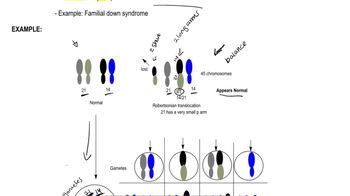A species has 2n = 20. How many chromosomes will be found per mutant cell in an autotriploid organism.
Table of contents
- 1. Introduction to Genetics51m
- 2. Mendel's Laws of Inheritance3h 37m
- 3. Extensions to Mendelian Inheritance2h 41m
- 4. Genetic Mapping and Linkage2h 28m
- 5. Genetics of Bacteria and Viruses1h 21m
- 6. Chromosomal Variation1h 48m
- 7. DNA and Chromosome Structure56m
- 8. DNA Replication1h 10m
- 9. Mitosis and Meiosis1h 34m
- 10. Transcription1h 0m
- 11. Translation58m
- 12. Gene Regulation in Prokaryotes1h 19m
- 13. Gene Regulation in Eukaryotes44m
- 14. Genetic Control of Development44m
- 15. Genomes and Genomics1h 50m
- 16. Transposable Elements47m
- 17. Mutation, Repair, and Recombination1h 6m
- 18. Molecular Genetic Tools19m
- 19. Cancer Genetics29m
- 20. Quantitative Genetics1h 26m
- 21. Population Genetics50m
- 22. Evolutionary Genetics29m
6. Chromosomal Variation
Chromosomal Mutations: Aberrant Euploidy
Problem 7e
Textbook Question
From the following list, identify the types of chromosome changes you expect to show phenotypic consequences.
Trisomy
 Verified step by step guidance
Verified step by step guidance1
Understand the concept of trisomy: Trisomy refers to a condition where an organism has an extra copy of a chromosome, resulting in three copies instead of the normal two. This is a type of aneuploidy, which is a deviation from the normal chromosome number.
Recognize the phenotypic consequences of trisomy: Trisomy often leads to phenotypic changes because the extra chromosome disrupts the normal balance of gene expression. This can result in developmental abnormalities or health issues.
Identify examples of trisomy in humans: Common examples include Trisomy 21 (Down syndrome), Trisomy 18 (Edwards syndrome), and Trisomy 13 (Patau syndrome). Each of these conditions is associated with specific phenotypic traits and health challenges.
Consider the mechanism behind phenotypic consequences: The extra chromosome leads to overexpression of genes located on that chromosome. This disrupts the tightly regulated processes of development and cellular function, causing observable phenotypic changes.
Evaluate the broader implications: Trisomy is a significant genetic change that typically results in noticeable phenotypic consequences. It is important to understand how such chromosomal abnormalities can impact an organism's overall health and development.
 Verified video answer for a similar problem:
Verified video answer for a similar problem:This video solution was recommended by our tutors as helpful for the problem above
Video duration:
1mPlay a video:
Was this helpful?
Key Concepts
Here are the essential concepts you must grasp in order to answer the question correctly.
Chromosome Structure and Function
Chromosomes are structures within cells that contain DNA, which carries genetic information. Each chromosome is made up of genes, and changes in chromosome structure can lead to alterations in gene expression. Understanding how chromosomes function is essential for grasping how changes can affect phenotypes.
Recommended video:
Guided course

Chromosome Structure
Trisomy
Trisomy is a type of chromosomal abnormality where an individual has three copies of a particular chromosome instead of the usual two. This can lead to various developmental and phenotypic consequences, as seen in conditions like Down syndrome (trisomy 21). Recognizing the implications of trisomy is crucial for understanding its effects on phenotype.
Recommended video:
Guided course

Robertsonian Translocations
Phenotypic Consequences
Phenotypic consequences refer to the observable traits or characteristics of an organism that result from the interaction of its genotype with the environment. Changes in chromosome number or structure, such as those caused by trisomy, can lead to significant phenotypic variations, impacting physical appearance, behavior, and overall health.
Recommended video:
Guided course

Mutations and Phenotypes
Related Videos
Related Practice
Multiple Choice
714
views
3
rank


